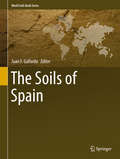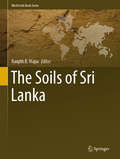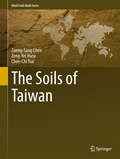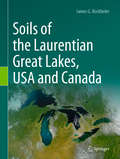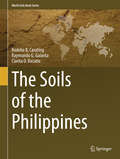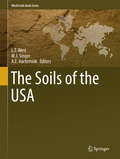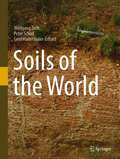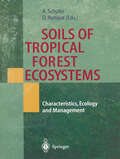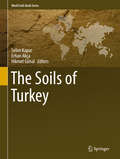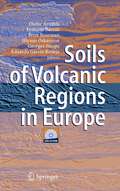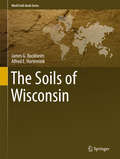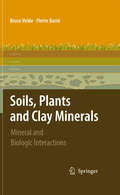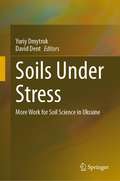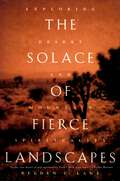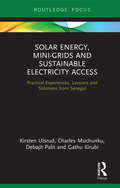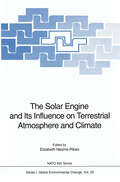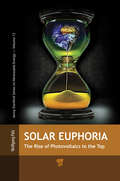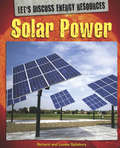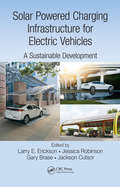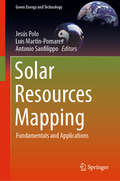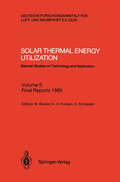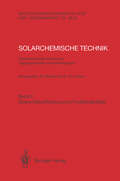- Table View
- List View
The Soils of Spain (World Soils Book Series)
by Juan F. GallardoThis book provides the reader with a comprehensive overview of the soils of Spain gathered by a variety of Spanish experts in the field. It presents soils in this country as particularly conditioned by the naturally diverse and drastic distribution of the Spanish landscape, characterized by mountainous ranges in the North, and arid areas in the South and the East. The first chapter sets the agricultural scenario in Spain as influenced by the Arabic culture and American agricultural products; the second chapter provides a classification and distribution of Spanish soils; the third chapter approaches the topic of soils in the characteristically humid Northern Iberia area as prone to diversity and soil evolution; the fourth focuses on the soils of the South and East of Spain as affected by lack of rainfall and abundance in calcic soil horizons; the fifth chapter deals with Mediterranean soils, having as a particular characteristic the dominance of red colors; and the last chapter discusses the challenges and future issues of Spanish soils.
The Soils of Sri Lanka (World Soils Book Series)
by Ranjith B. MapaThis book presents a comprehensive and up-to-date overview of the soils of Sri Lanka. Including sections on the soil research history, climate, geology, geomorphology, major soil types, soil maps, soil properties, soil classification, soil fertility, land use and vegetation, soil management, soils and humans, soils and industry, and future soil issues, the book summarizes the current state of knowledge in a concise and highly reader-friendly way.
The Soils of Taiwan (World Soils Book Series)
by Zueng-Sang Chen Zeng-Yei Hseu Chen-Chi TsaiThis book presents a comprehensive and up-to-date overview on soils of Taiwan. It includes sections on soil research history, climate, geology, geomorphology, major soil types, soil maps, soil properties, soil classification, soil fertility, land use and vegetation, soil management, soils and humans, soils and industry, future soil issues. The book summarizes what is known about the soils in Taiwan in a concise and highly reader-friendly way.
Soils of the Laurentian Great Lakes, USA and Canada
by James G. BockheimThis book introduces the reader to the Great Lakes and considers their soil-forming factors and processes, taxonomic structure of the soils, soil geography and pedodiversity, while also addressing the importance and protection of soils in the Great Lakes Coastal Zone. The Great Lakes are an important part of the USA and Canada. Home to 33 million people, including 90% of all Canadians, the Great Lakes account for 20% of the world’s surface freshwater and 90% of the USA’s freshwater. Key industries include shipping, steel and automobile production, energy generation, fishing, pulp and papermaking, agriculture, and recreation. To date, there has been no comprehensive inventory of the region’s soils, which are now subject to dramatic climate change and environmental degradation. This book was prepared using the US Department of Agriculture, Natural Resources Conservation Service databases, including the Web Soil Survey, Soil Series Extent Explorer, soil classification and characterization databases, and county soil surveys, supplemented by shoreline viewer software, the author’s independent research, consultation with colleagues, and survey trips around the Great Lakes.
The Soils of the Philippines (World Soils Book Series)
by Rodelio B. Carating Raymundo G. Galanta Clarita D. BacatioThe first soil survey in the Philippines was done by Mr. Clarence Dorsey, an American soil scientist in the province of Batangas in 1903. The Soils of the Philippines, however, is the first comprehensive summary of more than a century of soil-survey work in this country. It integrates the soil concepts of the reconnaissance soil-survey results, which commenced as early as 1934 and continued until the mid 1960s, with the semi-detailed soil surveys that continue to this day. The result is the first-ever genetic key for classifying Philippine soils at soil series level; thus, making it possible for any newcomers to the soil survey field to confidently produce their own soil map, at a more detailed map scale, to suit the project requirements.This book brings together discussions on soils and soil mapping units and up-to-date international techniques and technologies. It makes soils relevant to current political realities and national issues. As soil survey moves from a reductionist agricultural-development planning tool to a more holistic and integrated approach, to enable us to understand our dynamic and complex environment, The Soils of the Philippines will be the only source of authoritative and updated data on soil resources for macro-level resource management planning for decades to come.With a vanishing breed of experienced soil surveyors, not only in the Philippines but also worldwide, it may remain the only book on Philippine soils for the next hundred years or more. Since soils follow a geological and not a human time frame, the contents of this volume will stay relevant for soil surveyors even in a fast changing world.As the country leaps from an agricultural economy towards modernization and a more diversified economic base, some of the soil series in the Philippines, for example the Guadalupe series underlying the skyscrapers of Makati City, are becoming extinct as a result of urban development. Therefore, this book serves as the repository for the soils that we possess, the soils that have been lost through decades of urbanization while, at the same time, it creates a soil classification system for the soils we are yet to discover.
The Soils of the USA (World Soils Book Series)
by L. T. West M. J. Singer A. E. HarteminkThis book provides an overview of the distribution, properties, and function of soils in the U.S., including Alaska, Hawaii, and its Caribbean territories. It discusses the history of soil surveys and pedological research in the U.S., and offers general descriptions of the country’s climate, geology and geomorphology. For each Land Resource Region (LRR) – a geographic/ecological region of the country characterized by its own climate, geology, landscapes, soils, and agricultural practices – there is a chapter with details of the climate, geology, geomorphology, pre-settlement and current vegetation, and land use, as well as the distribution and properties of major soils including their genesis, classification, and management challenges. The final chapters address topics such as soils and humans, and the future challenges for soil science and soil surveys in the U.S. Maps of soil distribution, pedon descriptions, profile images, and tables of properties are included throughout the text.
Soils of the World
by Wolfgang Zech Peter Schad Gerd Hintermaier-ErhardThis book describes and comprehensively illustrates the soils of the world in accordance with the worldwide WRB classification. The structure of the book follows the ecozone concept. For every ecozone, location, climate and vegetation as well as soil formation and distribution are presented. All soils representative of the corresponding ecozone are then described in detail: definition, properties, distribution, use, classification, genesis. Over 260 photographs illustrate soil profiles, soil details and landscapes. Instructive maps and graphs help understand soil properties and soil-forming processes and make the publication an excellent reference book about the world's soils.
Soils of Tropical Forest Ecosystems: Characteristics, Ecology and Management
by Professor Dr. Andreas Schulte Dr Daddy RuhiyatAn understanding of the characteristics and the ecology of soils, particularly those of forest ecosystems in the humid tropics, is central to the development of sustainable forest management systems. The present book examines the contribution that forest soil science and forest ecology can make to sustainable land use in the humid tropics. Four main issues are addressed: characteristics and classification of forest soils, chemical and hydrological changes after forest utilization, soil fertility management in forest plantations and agroforestry systems as well as ecosystem studies from the dipterocarp forest region of Southeast Asia. Additionally, case studies include work from Guyana, Costa Rica, the Philippines, Malaysia, Australia and Nigeria.
The Soils of Turkey (World Soils Book Series)
by Selim Kapur Erhan Akça Hikmet GünalThis book compiles all available and relevant information concerning the soils of Turkey, including the soil survey studies conducted by universities and governmental institutes from the early 1950s until today. Recent findings and advances include the description and analyses of new profiles from some parts of the country by the chapter authors; reflecting the latest version of the World Reference Base (WRB) soil system, they produce a refined soil map. The book offers valuable guidance on soil management for planners of agricultural strategies, land management experts concerned with terrestrial carbon management (soil-sequestered and biomass carbon) and climate change mitigation, and educators concerned with raising awareness for the long-neglected significance of Turkey’s soils.
Soils of Volcanic Regions in Europe
by Peter Buurman Hlynur Oskarsson Georges Stoops Eduardo Garcia-Rodeja Ólafur Arnalds Francois BartoliThis book compiles information gained by an EU research network over six years of research on European volcanic soils. It gives comprehensive coverage of soils in volcanic regions within Europe, dealing with most aspects of modern day soil science. New methodology is introduced and the synthesis of the research casts a new light on soils with andic soil properties.
The Soils of Wisconsin (World Soils Book Series)
by James G. Bockheim Alfred E. HarteminkThis book provides an up-to-date and comprehensive report on the soils of Wisconsin, a state that offers a rich tapestry of soils. It discusses the relevant soil forming factors and soil processes in detail and subsequently reviews the main soil regions and dominant soil orders, including paleosols and endemic and endangered soils. The last chapters address soils in a changing climate and provide an evaluation of their monetary value and crop yield potential. Richly illustrated, the book offers both a valuable teaching resource and essential guide for policymakers, land users, and all those interested in the soils of Wisconsin.
Soils, Plants and Clay Minerals: Mineral and Biologic Interactions
by Pierre Velde Pierre BarréThis book represents a rather complicated history of encounters, changes in research interest and some very interesting results. Initially it is the very fruitful interaction of Ecology and Geology. The point of view of ecologists is extremely refreshing for hard science people. Interaction and inter-relationships are the focus of Ecology whereas the traditional sciences, such as Geology, have tried to isolate the natural phenomena so that thye could be studied in a more rigorous manner. The traditional sciences were of course natural science – based since the world to be observed was at the door step of everyone, mountains, weather patterns, plants and so forth. Chemistry and Physics were de ned after Mathematics in order to establish more precise and viable principles of the behavior of the materials that formed the world around mankind. It became quite clear that the observation of the natural world was too complicated to consider all of the possible variables which could affect an observed process or situation. The systems were simpli ed and taken into the laboratory in order to better master the phenomena observed. Physics c- cerned itself with non-reacting materials, subjected to essentially mechanical forces.
Soils Under Stress: More Work for Soil Science in Ukraine
by Yuriy Dmytruk David DentDokuchaev carried out most of his research in Ukraine. His student and friend, Volodymyr Vernadsky, went on to create trans-disciplinary environmental sciences and the concept of Earth as a living organism, famously taken up by James Lovelock. That spring of ideas still flows and the researches captured in this volume are relevant to present-day problems, and not only in Ukraine.Soils have always been under stress but, in the Anthropocene, mankind is in the driving seat. As a sequel to Soil Science Working for a Living: Applications of soil science to present-day problems, we consider issues of policy as well as soil genesis, attributes and functions in various environments, natural and man-made. We consider human impacts on the soil cover through its use and misuse, highlight methods of research and assessment of soil quality, and the threats of soil degradation. The distinguished contributors also describe and propose various options for evaluation and remediation of degraded soils, drawing on the latest methods of modelling and cartography as well as long-term field experiments and long experience.The book will be invaluable to researchers and practitioners in soil science including graduate and post-graduate education, academics and professionals.
The Solace of Fierce Landscapes: Exploring Desert and Mountain Spirituality
by Belden C. LaneIn the tradition of Kathleen Norris, Terry Tempest Williams, and Thomas Merton, The Solace of Fierce Landscapes explores the impulse that has drawn seekers into the wilderness for centuries and offers eloquent testimony to the healing power of mountain silence and desert indifference. Interweaving a memoir of his mother's long struggle with Alzheimer's and cancer, meditations on his own wilderness experience, and illuminating commentary on the Christian via negativa--a mystical tradition that seeks God in the silence beyond language--Lane rejects the easy affirmations of pop spirituality for the harsher but more profound truths that wilderness can teach us. "There is an unaccountable solace that fierce landscapes offer to the soul. They heal, as well as mirror, the brokeness we find within." It is this apparent paradox that lies at the heart of this remarkable book: that inhuman landscapes should be the source of spiritual comfort. Lane shows that the very indifference of the wilderness can release us from the demands of the endlessly anxious ego, teach us to ignore the inessential in our own lives, and enable us to transcend the "false self" that is ever-obsessed with managing impressions. Drawing upon the wisdom of St. John of the Cross, Meister Eckhardt, Simone Weil, Edward Abbey, and many other Christian and non-Christian writers, Lane also demonstrates how those of us cut off from the wilderness might "make some desert" in our lives. Written with vivid intelligence, narrative ease, and a gracefulness that is itself a comfort, The Solace of Fierce Landscapes gives us not only a description but a "performance" of an ancient and increasingly relevant spiritual tradition.
Solar Energy, Mini-grids and Sustainable Electricity Access: Practical Experiences, Lessons and Solutions from Senegal (Routledge Focus on Environment and Sustainability)
by Debajit Palit Kirsten Ulsrud Charles Muchunku Gathu KirubiThis book presents new research on solar mini-grids and the ways they can be designed and implemented to provide equitable and affordable electricity access, while ensuring economic sustainability and replication. Drawing on a detailed analysis of solar mini-grid projects in Senegal, the book provides invaluable insights into energy provision and accessibility which are highly relevant to Sub-Saharan Africa, and the Global South more generally. Importantly, the book situates mini-grids in rural villages within the context of the broader dynamics of national- and international-level factors, including emerging system innovation and socio-technical transitions to green technologies. The book illustrates typical challenges and potential solutions for practitioners, policymakers, donors, investors and international agencies. It demonstrates the decisive roles of suitable policies and regulations for private-sector-led mini-grids and explains why these policies and regulations must be different from those that are designed as part of an established, centralized electricity regime. Written by both academics and technology practitioners, this book will be of great interest to those researching and working on energy policy, energy provision and access, solar power and renewable energy, and sustainable development more generally.
Solar Energy, Mini-grids and Sustainable Electricity Access: Practical Experiences, Lessons and Solutions from Senegal (Routledge Focus on Environment and Sustainability)
by Debajit Palit Kirsten Ulsrud Charles Muchunku Gathu KirubiThis book presents new research on solar mini-grids and the ways they can be designed and implemented to provide equitable and affordable electricity access, while ensuring economic sustainability and replication. Drawing on a detailed analysis of solar mini-grid projects in Senegal, the book provides invaluable insights into energy provision and accessibility which are highly relevant to Sub-Saharan Africa, and the Global South more generally. Importantly, the book situates mini-grids in rural villages within the context of the broader dynamics of national- and international-level factors, including emerging system innovation and socio-technical transitions to green technologies. The book illustrates typical challenges and potential solutions for practitioners, policymakers, donors, investors and international agencies. It demonstrates the decisive roles of suitable policies and regulations for private-sector-led mini-grids and explains why these policies and regulations must be different from those that are designed as part of an established, centralized electricity regime. Written by both academics and technology practitioners, this book will be of great interest to those researching and working on energy policy, energy provision and access, solar power and renewable energy, and sustainable development more generally.
The Solar Engine and Its Influence on Terrestrial Atmosphere and Climate (Nato ASI Subseries I: #25)
by Elizabeth Nesme-RibesThe message of sunspots from the interior of the Sun to the Earth's climate When Galileo was summoned before the Inquisition on April 12, 1633, the main accusations laid against him concerned the doubts he expressed about Aristotle's theory of the universe. Aristotle's idea was that the Earth was the centre of the cosmos and that all of the stars, including the Sun, turned around it. Moreover, for Aristotle and the world of the Inquisitors, the Sun was a perfect celestial body. Now, Galileo had discovered spots on the Sun. These spots were seen as imperfections, and not just surface markings, but coming from within the Sun. Worse yet, they revolved around the Sun. All this supported the newfangled theory of Copernicus, and undermined a system of thought that had reigned supreme for centuries. Man of science that he was, and a prudent Catholic too, Galileo strived all his life to prove that Copernicus' astronomical concept was compatible with the word of the Bible. He proposed that there were not two truths but a single divine truth. It was just expressed in two different languages : there was the language of the common people, with its imprecision and inconsistencies, but intuitively understandable by everyone; and then there was the precise language of science with its strict regard for observation, which only a chosen few can grasp [L. Geymonat. 1992].
Solar Euphoria: The Rise of Photovoltaics to the Top
by Wolfgang PalzPhotovoltaics (PV), the solar power, which was nothing a few years ago, is the world leader in clean and sustainable energy today. It has become low-cost and affordable for everybody: Millions of people have already invested in it. This book reports on the euphoria resulting from solar PV that started about half a century ago in the United States, followed by Japan. By the turn of the century was triggered the first PV market explosion in Germany, followed by the great financial and industrial turmoil ending up with China’s leadership. Today, the solar euphoria has embraced the whole world, with hundreds of billions of dollars being invested in millions of PV plants on buildings or on the ground. The book is a guide to investing while helping to save the environment. It tells everything about solar power.
Solar Euphoria: The Rise of Photovoltaics to the Top
by Wolfgang PalzPhotovoltaics (PV), the solar power, which was nothing a few years ago, is the world leader in clean and sustainable energy today. It has become low-cost and affordable for everybody: Millions of people have already invested in it. This book reports on the euphoria resulting from solar PV that started about half a century ago in the United States, followed by Japan. By the turn of the century was triggered the first PV market explosion in Germany, followed by the great financial and industrial turmoil ending up with China’s leadership. Today, the solar euphoria has embraced the whole world, with hundreds of billions of dollars being invested in millions of PV plants on buildings or on the ground. The book is a guide to investing while helping to save the environment. It tells everything about solar power.
Solar Power: Solar Power Library Ebook (Let's Discuss Energy Resources #2)
by Richard Spilsbury Louise SpilsburyWith supplies of non-renewable energy sources running low and the threat of global warming and climate change, there is an urgent need to look at other types of energy resources and how well they can meet our power needs. While new technologies are being developed, each energy resource comes at a cost. This series looks at each energy resource, the technology and cost of how it is used to meet power needs and how it impacts the environment and humans. Each book explains how that power is generated and where it is used, and then, using specific Let's Discuss panels, explores the various advantages and disadvantages that concern it's use as an alternative fuel source. Case studies examine specific usage examples where that source has either worked or not worked so that the reader can weigh up the pros and cons for the use of each source against the alternatives.
Solar Powered Charging Infrastructure for Electric Vehicles: A Sustainable Development
by David Morley, Xiaoming Li, Crispin JenkinsonThe Paris Agreement on Climate Change adopted on December 12, 2015 is a voluntary effort to reduce greenhouse gas emissions. In order to reach the goals of this agreement, there is a need to generate electricity without greenhouse gas emissions and to electrify transportation. An infrastructure of SPCSs can help accomplish both of these transitions. Globally, expenditures associated with the generation, transmission, and use of electricity are more than one trillion dollars per year. Annual transportation expenditures are also more than one trillion dollars per year. Almost everyone will be impacted by these changes in transportation, solar power generation, and smart grid developments. The benefits of reducing greenhouse gas emissions will differ with location, but all will be impacted. This book is about the benefits associated with adding solar panels to parking lots to generate electricity, reduce greenhouse gas emissions, and provide shade and shelter from rain and snow. The electricity can flow into the power grid or be used to charge electric vehicles (EVs). Solar powered charging stations (SPCSs) are already in many parking lots in many countries of the world. The prices of solar panels have decreased recently, and about 30% of the new U.S. electrical generating capacity in 2015 was from solar energy. More than one million EVs are in service in 2016, and there are significant benefits associated with a convenient charging infrastructure of SPCSs to support transportation with electric vehicles. Solar Powered Charging Infrastructure for Electric Vehicles: A Sustainable Development aims to share information on pathways from our present situation to a world with a more sustainable transportation system with EVs, SPCSs, a modernized smart power grid with energy storage, reduced greenhouse gas emissions, and better urban air quality. Covering 200 million parking spaces with solar panels can generate about 1/4 of the electricity that was generated in 2014 in the United States. Millions of EVs with 20 to 50 kWh of battery storage can help with the transition to wind and solar power generation through owners responding to time-of-use prices. Written for all audiences, high school and college teachers and students, those in industry and government, and those involved in community issues will benefit by learning more about the topics addressed in the book. Those working with electrical power and transportation, who will be in the middle of the transition, will want to learn about all of the challenges and developments that are addressed here.
Solar Powered Charging Infrastructure for Electric Vehicles: A Sustainable Development
by Larry E. Erickson Jessica Robinson Gary Brase Jackson CutsorThe Paris Agreement on Climate Change adopted on December 12, 2015 is a voluntary effort to reduce greenhouse gas emissions. In order to reach the goals of this agreement, there is a need to generate electricity without greenhouse gas emissions and to electrify transportation. An infrastructure of SPCSs can help accomplish both of these transitions. Globally, expenditures associated with the generation, transmission, and use of electricity are more than one trillion dollars per year. Annual transportation expenditures are also more than one trillion dollars per year. Almost everyone will be impacted by these changes in transportation, solar power generation, and smart grid developments. The benefits of reducing greenhouse gas emissions will differ with location, but all will be impacted. This book is about the benefits associated with adding solar panels to parking lots to generate electricity, reduce greenhouse gas emissions, and provide shade and shelter from rain and snow. The electricity can flow into the power grid or be used to charge electric vehicles (EVs). Solar powered charging stations (SPCSs) are already in many parking lots in many countries of the world. The prices of solar panels have decreased recently, and about 30% of the new U.S. electrical generating capacity in 2015 was from solar energy. More than one million EVs are in service in 2016, and there are significant benefits associated with a convenient charging infrastructure of SPCSs to support transportation with electric vehicles. Solar Powered Charging Infrastructure for Electric Vehicles: A Sustainable Development aims to share information on pathways from our present situation to a world with a more sustainable transportation system with EVs, SPCSs, a modernized smart power grid with energy storage, reduced greenhouse gas emissions, and better urban air quality. Covering 200 million parking spaces with solar panels can generate about 1/4 of the electricity that was generated in 2014 in the United States. Millions of EVs with 20 to 50 kWh of battery storage can help with the transition to wind and solar power generation through owners responding to time-of-use prices. Written for all audiences, high school and college teachers and students, those in industry and government, and those involved in community issues will benefit by learning more about the topics addressed in the book. Those working with electrical power and transportation, who will be in the middle of the transition, will want to learn about all of the challenges and developments that are addressed here.
Solar Resources Mapping: Fundamentals and Applications (Green Energy and Technology)
by Jesús Polo Luis Martín-Pomares Antonio SanfilippoThis book presents methods for optimising the spatial and network configuration of solar radiation measuring stations. Various physical and mathematical models are demonstrated, which together with high quality measurements, provide the essential tools to generate and validate solar resource estimates to improve the mapping of solar resources.Each chapter deals with a specific topic, showing its methodology, and providing examples of how to apply these techniques with reference to current projects around the world. These topics include:· Radiometric measurement campaigns;· Equipment calibration, installation, operation, and maintenance;· Data quality assurance and assessment;· Solar radiation modelling from satellite images and numerical models;· Downscaling and kriging interpolation of solar radiation;· Simulation of electric solar power plant generation;· Solar radiation forecasting;· Applications of solar energy; and· Socio-economic benefits of solar energy.The contributors present the statistical and physical models needed to derive solar radiation from satellite images and numerical models, emphasising the importance of measuring solar radiation accurately. They also show the classical models used to generate synthetic data, clear sky models and ancillary air quality and meteorological data from different input sources.Solar Resources Mapping provides industry professionals with methodologies and tools to build solar irradiance maps for different applications. The book will also benefit students and researchers as it serves as a main technical reference, presenting the basic terminology and fundamentals for solar resource mapping that include methods for assessing measurement uncertainty.
